
FONTAINEBLEAU CASTLE
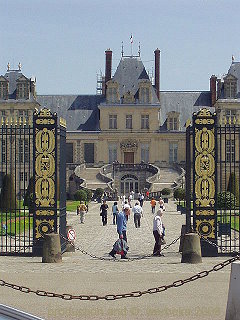 |
If you want to describe such a big castle as Fontainebleau, then it is like you should write down the history of one century on a single piece of paper. When I was there, the batteries of my camera became empty. I put in my spare batteries - but before I was through the castle, they too were empty. How could one describe this castle completely, considering the multitude of information? It is simply impossible - this page contains therefore just some of the impressions, it will still be more than enough.
You enter the area of the castle through the Yard of the White Horse. Here there was a monastery before, which had been founded by Saint Louis, or - in other terms - Louis IX. The name of the yard originates from a plaster-horse, which Katharina de Medici wanted to be built here. This was a reconstruction of a statue - Marcus Aurelius on a horse - of which the original was placed in Rome. |
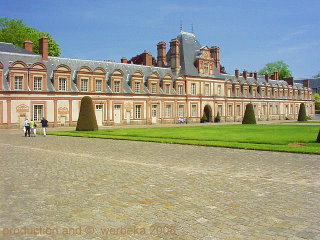 |
You won't be far from the truth, if you assume, that Katharina wanted to get over her homesickness by looking at the statue. But already in the 17th century the horse was taken away again.
The curved staircase was initiated by Henry II and constructed by Philibert Delorme, but was soon ramshackled and had to be replaced with the present staircase in the 17th century. Now the constructor was Jean Androuet Du Cerceau.
From the beginning the castle had two equal wings, like the one on the picture to the left, which framed the yard. But the second wing was replaced by Louis XV with a building of three floors. |
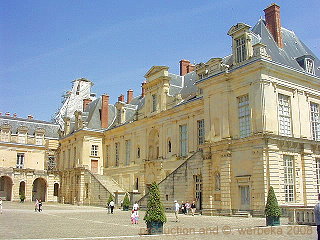 |
We decide, first to get an overview of the area surrounding the castle and reach the Yard of the Fountain after having gone through a passage. And yes, there is a fountain here, but it is far from impressive, even if it shall depict Odysseus. A discus thrower stands on a pedestal over four watering lionheads. Far more impressive is the adjoining carp pond with its pavilon in the middle of the water - as well as the surrounding buildings. At the opposite side of the pond and in a right angle to the face of the main building there is the Gallery of King Francis I (in the background on the picture).
|
|
To the right of it there is the Wing of the Beautiful Fireplace with the two sideway staircases. On the opposite side, and at the same time the backside of the main building, there is the Wing of the Queen's Mother. This is finished through a pavilon, which on behalf of Louis XV in 1750 replaced one from the 16th century. There you can find the Chinese Museum today. The items within were collected by Empress Eugénie, the spouse of Napoleon III. Things with Chinese or Japanese origin were an important trend in the 19th century. Even in the yard you can see some influence of that - there are Chinese lions.
One disagrees by the way about the origin of the name of the castle (and the village).
Fontaine is fountain, that is no problem, but if the second part really means "blue" (the "a" in bleau should not be there), is rather discussionable. Another theory says that it is a contraction of "belle eau" - that is "beautiful (good) water". Then it would be the equivalent to "source of beautiful water" - "Schönbrunn" in German. |
 |
| The Gallery of Francis I was built in 1528 and leads to the next yard, the so called "Oval Yard", where the oldest parts of the castle are found. The quadrangular donjon is from the 12th century and the buildings around it were erected by Francis I and his son Henry II. Also the Port of the Dauphin should be mentioned, which leads its name back to the christening of the heir to the throne, Louis XIII, on September 14th, 1606. Through this port one reaches the last yard, the Yard of Henry IV, also called Officium-Yard. Henry IV was the father of Louis XIII, as well as of the buildings, surrounding this yard. Here there were the kitchens and the dwellings of the officers. The coaches had to be left here, before entering the Oval Yard.
Before entering the castle itself, some words about the gardens, which surround the castle. They have gone through quite some changes throughout the centuries, but nevertheless they are worth a glance or two even today.
|
 |
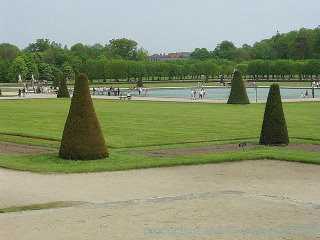 |
To the right of the entrance, behind the wing built by Louis XV and all around the carp pond, there is the English Garden. To the left behind the Yard of the Fountain and the Oval Yard, the Garden of Diana is situated. Its name derives from the statue of the Goddess of Hunting, who stands on top of a well there. The Big Parterre finally (here on the image) was built under the reign of the Sun King, Louis XIV. It was constructed by André Le Nôtre and is the biggest of its kind in Europe. Behind it there is even another park, created by Henry IV for hunting purposes. The trees there were planted in straight rows, to make the killing of the game easier. |
| The striking thing, once you enter the castle, are the many paintings, which in abundance fill the walls as well as the ceilings. While you, dear reader, take delight in the images on the sides, I shall retell some of the castle's history.
The first mentioning of a castle in Fontainebleau is from the 12th century - from this time originates the donjon in the Oval Yard as well. In 1169 the castle's chapel was consecrated to the Holy Saturninus, and this by a well-known historical person. It was the Archbishop of Canterbury, Thomas Becket, who accomplished that ritual, because he lived in France in exile at this time. Almost one century later, Louis IX founded a monastery of the Holy Trinity, part of which was a hospital. King Philipp IV, the Fair, was born at Fontainebleau Castle (in 1268) and died there as well (in 1314). |
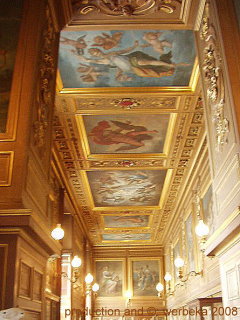 |
1528 was the year of the next important change in the castle's history. King Francis I started an extensive modification of the castle. Except the old donjon, all the other buildings around the Oval Yard were erected, as well as the Gallery, which combines the new buildings with those surrounding the Yard of the White Horse. Even those were built after Francis instructions. The buildings in the Yard of the Fountain are from his son and successor, Henry II, and the latter's wife Katharina de Medici.
Francis I entrusted artists from Italy with the completion, such as e.g. Rosso from Florence and Primaticcio from Bologna, in order to transfer the ideas of the Renaissance to France. These artists are known as the First School of Fontainebleau. The Saliera by the goldsmith Cellini, the salt-cask, which was stolen from the Kunsthistorisches Museum (Museum of Art) in Vienna at the beginning of our century - but in the meantime already retrieved - was originally made for the French king. Charles IX gave it later as a present to Ferdinand II of Hapsburg - this way the Saliera ended up in Vienna.
Francis I was also a sedulous collector of paintings, sculptures, gems and tapestries, etc. Therefore Fontainebleau became a cultural centre at this time. In 1539 Emperor Charles V of Hapsburg came for a visit and was impressed.
|
 |
Five years later a new king was born here - the grandchild with the same name, who eventually became Francis II. Still seven years after this, his brother, the later Henry III saw the light of day here. Unfortunately the govering times of those successors of Francis I were not really good ones - the wars between catholics and protestants overshadowed everything - and the castle was even abandoned.
The tide turned with Henry IV. His extensive renovation of the entire castle led to the Second School of Fontainebleau, involving artists like Ambroise Dubois from Antwerp and Antoine Caron from Paris. In 1601 Louis XIII was born here, whose christening was reason for the namegiving of the Port of the Dauphin. In 1629 this King signed the peace treaty with England here in Fontainebleau.
The next event, a scandal, was caused by the Swedish Queen Christina in 1657. |
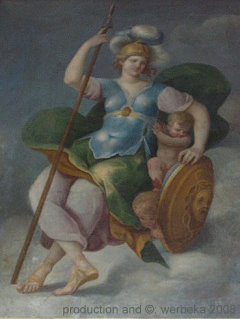 |
She had resigned the Crown of Sweden, because she had converted to catholicism in that protestant country. Her equerry Monaldeschi had been her favourit for a long time. But when she started to prefer the Chief of the Guards, Monaldeschi became jealous. He wrote a couple of perfidious and scandalous letters in his competitor's name and spread them among the rulers of Europe. But Christina saw through this trick and had Monaldeschi murdered, while she was visiting Fontainebleau. Of course this is not really the nicest way of conduct, no wonder that the Pope didn't want to see her afterwards ...
At the end of the 17th century Louis XIV came here every autumn to hunt. In 1685 he abolished the Edict of Nantes, which led to religious uprisings and made lots of protestants flee the country. In Fontainbleau the Sun King accepted as well the Spanish Crown in 1700 - for his grandson Philipp de Anjou, who later came to reign in Spain as Philipp V. But at the same time the War of the Spanish Succession was triggered. |
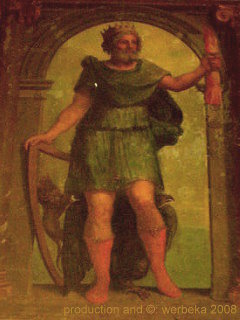 |

 |
Important events in the castle during the last three centuries: Tsar Peter the Great came for a visit (1717). Louis XV married Maria Leczinska, the daughter of the King of Poland (1725). An opera of Jean-Jacques Rousseau had its premiere here in 1752: Le devin du village (The Village Soothsayer). The beginning of the 19th century was influenced entirely by Napoleon. In 1803 he organized the Military Academy here, which had to move out five years later, though. Pope Pius VII came in 1804 to the crowning of Napoleon - and in 1812 once more, but this time he was held prisoner by Napoleon for 19 months. Then the Pope signed the Concordat of Fontainebleau, which he immediately revoked, when he came free. In 1814 Napoleon was banished to the island of Elba and took farewell of his guard in the Yard of the White Horse. Since then the yard also is called the Yard of Farewell. In 1837 Ferdinand-Philippe, the Count of Orléans married Helene von Mecklenburg-Schwerin. Napoleon III recieved here the Ambassador of the King of Siam (1861). In the 20th century the castle was mainly a place for meetings and conferences, apart from the years 1949 - 1966, when the Chief Commander of the NATO was installed here.
But now enough of history, let us look into some interesting chambers: |
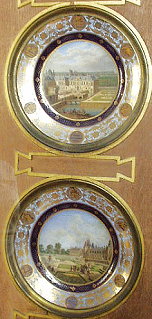 |
Rather at the beginning of the round tour you reach the Gallery of Plates. Here you can see the Historical Service of Fontainebleau. It was never actually used, but King Louis-Philippe let the 128 plates build into the wooden panels. They show motives from Fontainebleau and other Royal castles, as well as places, which the King had visited.
But it isn't only this idea, that is inventive and because of that worth seeing - there is more or less something in every room, which makes you catch your breath. Regardless if it is a beautiful vase, an excellent picture of Francis I, or if it is a well worked and nicely placed piece of furniture - there is so much to see, that one can't take in all of it. Besides there is the decoration of the walls and the paintings on the ceilings ...
|
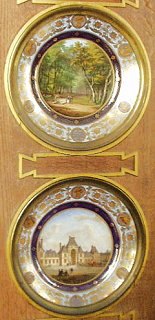 |
 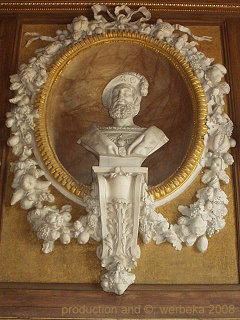 
But, of course one shouldn't forget the social disadvantages of such abundance - it is irresponsible to bask in riches, while the subjects are hungry. On the other hand we would not be able to enjoy this cultural heritage, if that hierarchy hadn't existed. When Napoleon came to Fontainebleau after the French Revolution, he found a more or less empty and destroyed castle. It is a pity that the lack of culture is a sister of freedom, equality and brotherhood ...
 |
Even if many pieces of furniture and accessories are authentic, that word must be understood as "starting at the beginning of the 19th century". Floors, ceilings and pictures are often of older origin, though. This group of figures was made by Primaticcio between 1541 and 1544, in a chamber that had the history of Alexander the Great and Roxane as motive. The elongated bodies make you see clearly the ideas of Mannerism. It is found above the door of the Royal staircase. The location was changed into a staircase under Louis XV. Earlier it had been the bedroom of Madame d'Etampes, the mistress of Francis I. |
In these chambers Napoleon held the Pope a prisoner, it was not really a hollow and dark cellar ... Before that, this had been the bedroom of Anna of Austria, who actually had been a Spaniard. She only held the title "Archduchess of Austria". The House of Hapsburg had split up into a Spanish and an Austrian part, about a hundred years ago. But she was even called "Anna from Spain". However one wants to call her, she was the mother of the Sun King, Louis XIV, whom she gave birth to aged 37 and after 23 years of marriage. She was a very cultural woman, who had only very few mutual interests with her husband Louis XIII. On the other hand she was very close to her son. That should explain, why the Sun King later was to promote culture in France, which led to a heyday.
But back to Anna: when Richelieu in 1635 declared war on Spain, she was - naturally - very upset. But when her husband died in 1643, she took the reign for her underage son. |
 |
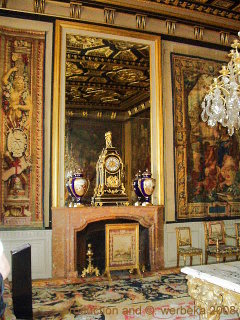 |
She surprised everybody by continuing the war, instead of making peace with her brother Philipp.
The image to the left shows her antechambre, in which she had installed the ceiling from the bedroom of Henry II. The image to the right shows a part of it. The woodwork consists of nine parts, of which seven are symbols for the planets. The one on the image shows Venus, looking at herself in a mirror.
|
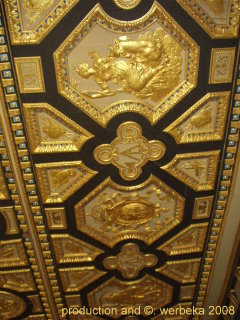 |
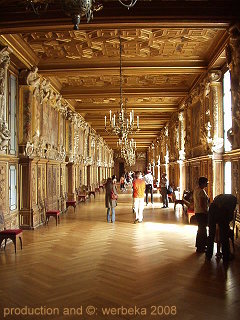 |
Now I would like to show you two very large places in the castle. First the Gallery of Francis I, which is no less then sixty meters long, and in which one easily could spend a whole day, studying the details. On the panels of nutwood the "F" of the King and his heraldic animal, the salamander, alternate. Above the panels there are frescos and stuccowork, which mainly orientate at events of the ancient world.
|
 |
But at the same time they are a homage to the King. In my opinion with all reason, because Francis is probably the king of the Renaissance, who had the biggest interest in culture, even if the others not at all were insignificant.
After the gallery, I would like to show you the ballroom, which only is half as long as the gallery, but which has so many nice alcoves. From ten big windows in the alcoves one can look upon the Oval Yard to the north and the Big Parterre to the south.
 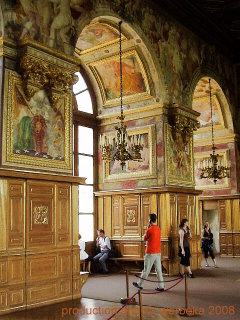 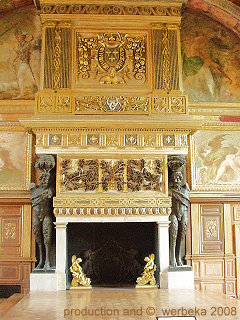
The original bronzes of the satyres by Primaticcio in front of the fireplace were melted down during the Revolution and only rebuilt in 1966.
 |
The first chapel of Saint-Saturninus from 1169, Francis I also let rebuild after the original drawings. Here a view into the cupola, which seems to be magically illuminated through the light entering in the upper level.
The image down to the left shows the parlour of Francis I, which got this name by his successors, because at the time of Francis it was the bedroom of the King's second wife, Eleonore of Austria. In 1565 it was degraded to an antechambre, while it later became a dining room. The furniture of today in the style of Louis XIV dates from the Second Empire.
|
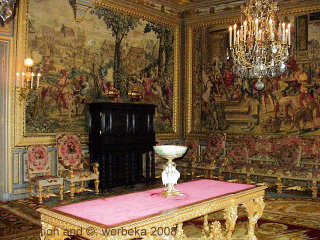 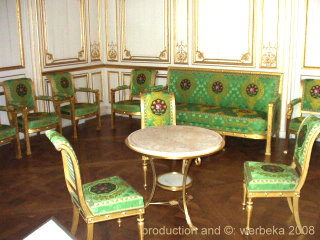
Up to the right we see the "White Chamber", where there once was a cabinet for Maria de Medici, the spouse of Henry IV. The panels on the walls are in Louis XV-style and the furnishing of the room from about 1800.
| Now we are in the Gallery of Diana, which was erected by Henry IV for his wife and which shows the myths of the Roman goddess Diana (or the Greek Artemis). The gallery measures eighty meters in length and is seven meters wide. Napoleon III made a library of this room in 1858. There are 16000 volumes kept, from the library of Napoleon I.
The room of the Empress (which means Eugénie, but since the 16th century all female rulers have slept here), looks today as it was furnished at the time of Empress Joséphine. The decor of the room reminds us of more ladies. |
 |
A part of the ceiling is from the 17th century and remembers of Anna of Austria (married to Louis XIII). The fireplace with the mirror belonging to it, as well as the lower panel are works which Maria Leczinska (Louis XV) let carry out, the doors including the top frames are from Marie-Antoinette (Louis XVI), whereas the tapestry and the furnishing are due to Joséphine (Napoleon I).
The silken tapestry was woven between 1968 and 1986 after an original pattern from 1790. The bed was made for Marie-Antoinette, though she never did use it.
|
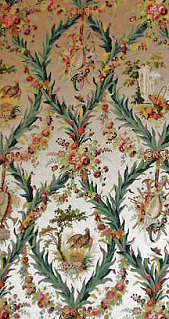 |
 |
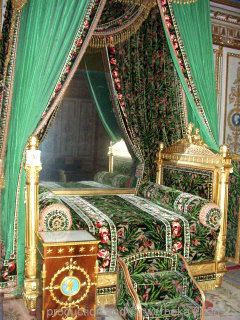 |
Let us finish our round-tour with the chambers of the Emperor, that is Napoleon I. Here we can see his private rooms, to the left the official bedroom, but to the right the small bedroom, which actually was his working cabinet. He could retreat to this room, far off the turbulence of the court. Here was also his desk, which could be locked by repositioning an extendable board.
|
 |
 |
Finally we see the throne of the Emperor, which is positioned in the former bedroom of Louis XIV.
And we can see that the French have succeeded in retrospectively putting some divine aura on Napoleon. In my eyes he was as big a megalomaniac commander as for instance Alexander the Great or Adolf Hitler. How many lives has he got on his conscience? In spite of this he is almost glamourised! When is the world going to see, that every - even unknown - inventor or scientist is worth our remembrance much more, if he helped mankind just a tiny bit ahead?
But that has nothing to do with Fontainebleau - the castle is, in spite of its rulers, a part of mankind's cultural history. It were not the rulers after all, who have created all of this with their own hands. |
© Bernhard Kauntz, Wolvertem 2008
Back to  or to the or to the  of of 
last update: 15.12.2008 by webmaster@werbeka.com
|






































